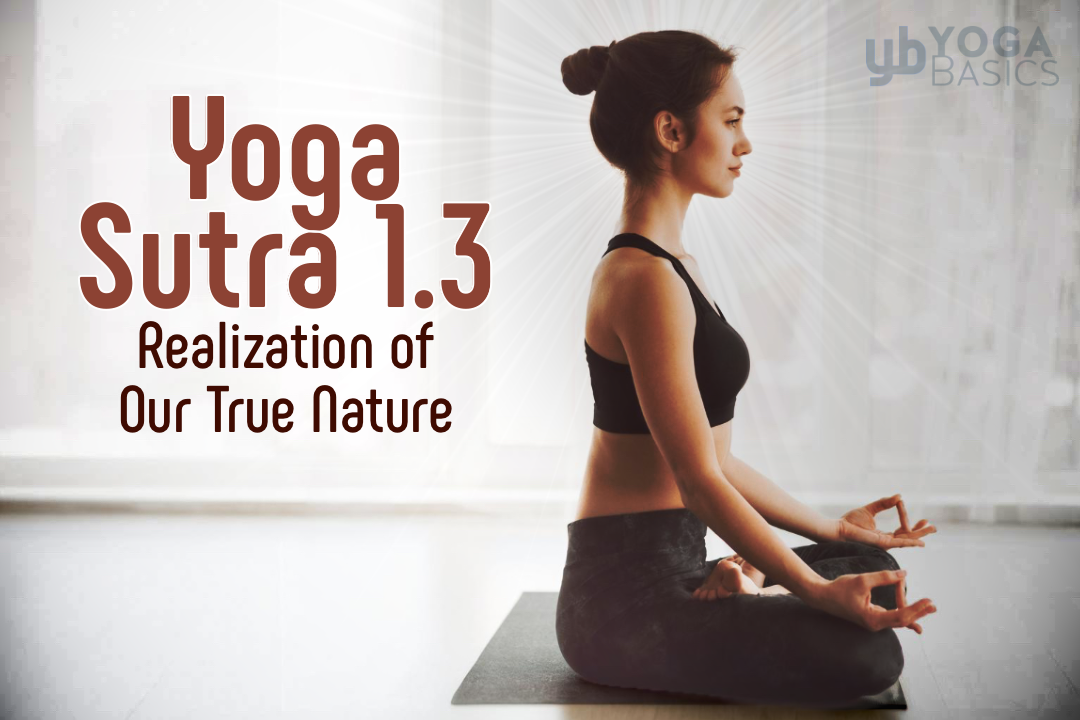Beneath the layers of distractions and the relentless noise of our thoughts lies the core of who we really are. Patanjali’s third Yoga Sutra encourages us to strip away these layers, revealing the brilliant gem of our true selves—a stillness, a purity, a radiant essence that is eternally unchanging. This sutra serves as a guiding light, illuminating the path toward self-realization and inner peace. Put simply, Sutra 1.3 tells us, when the mind ceases its constant chatter, you can finally see who you truly are!
In Sanskrit, this sutra is expressed as “Tad? dra??u? svar?pe’vasth?nam.” Sri Swami Satchidananda’s translation is the most commonly used: “Then the seer (the self) abides in its own true nature.” This sutra describes when the yogi, through the practice of meditation, stills the fluctuations of the mind. In that stillness, one experiences a state of pure awareness. Discovering our true selves is not easy. It requires us to break free from distractions and mental turmoil. We must let go of the false identities our egos create—those illusions that cloud our perception and keep us from seeing clearly.
Translation Yoga Sutra 1.3
Sanskrit: ??? ???????? ???????????????????
Transliteration: Tad? dra??u? svar?pe’vasth?nam
Word for word translation:
- tad? = then or only after, suggesting that this state is achieved after the cessation of mental fluctuations (v?ttis).
- dra??u? = the true self, the soul, the seer, or the pure consciousness that observes without being subject to change.
- sva = own
- r?pe = color, form, nature
- avasth?nam = rests, abides
Other Popular Translations
“Then The Seer Abides In Itself” — Hariharananda Aranya
“Then the Seer is established in his own essential nature.” — I. K. Taimni
“When thought ceases, the spirit stands in it’s true identity as observer to the world.” — Barbara Miller
“At that time (the time of concentration) the seer (Purusha) rests in his own (unmodified) state.” — Swami Vivekananda
“When that is accomplished, the seer abides in its own true nature.” — Edwin Bryant
The Path of Self-realization
The path to self-realization, as outlined in Yoga Sutra 1.3, involves a deep commitment to meditation practice, self-inquiry, devotion, and detachment. This journey requires diligence, as the mind’s fluctuations, known as vrittis, are deeply embedded patterns. These mental shifts—as thoughts, emotions, and sensory experiences — bind us to a narrow identity, one heavily influenced by external situations and the approval of others.
When we recognize the drashtuh—the “seer” within us—we tap into our true nature. In this state of witness consciousness, we begin to distinguish between the transient nature of our thoughts and emotions and the eternal essence of our being. This process is akin to calming a turbulent sea; as the waters settle, we begin to glimpse the clarity beneath the surface. In this state of stillness, the true Self emerges, revealing itself as pure consciousness—free from the distortions of the mind.
The Role of Self-Inquiry
The path of jnana yoga is a quest for spiritual knowledge and wisdom. At the core of this exploration lies self-inquiry, or atma-vichara. This introspective practice invites seekers to deeply examine their essential nature. One ponders profound questions such as, “Who am I?”, “Am I just my body or mind?” and “Are my thoughts truly me?” These questions encourage yogis to cultivate discernment (viveka), to differentiate the real (the eternal Self) from the unreal (the ego’s identity, thoughts and emotions).
Through rigorous self-inquiry, the layers of false identification and spiritual ignorance—those woven from past experiences, societal roles, and cultural expectations—begin to unravel. Ramana Maharshi taught that persistent contemplation on the origin of the ‘I’-thought will eventually dissolve it into pure self-awareness. Instead of identifying with the ever-changing landscape of our thoughts, we become the steadfast observer, the witness that experiences life, yet remains unaffected by its fluctuations.
The Journey of Letting Go
Attachments to material possessions, relationships, sense objects, and outcomes clouds our perception and anchors us to our limited egoic identity. The practice of detachment, or vairagya, is essential in reducing our mental fluctuations. When we let go of our attachments, we no longer derive our sense of self-worth from external sources or cling to transient experiences.
Our attachments often perpetuate a cycle of suffering and dissatisfaction. The practice of vairagya enables us to approach life from a place of inner freedom. It does not imply apathy or renunciation of the world; rather, it helps us be more present in the moment and to maintain equanimity in the face of life’s inevitable ups and downs.
The Path of Devotion
Bhakti is a yoga practice that emphasizes surrendering the individual ego to a higher power or divine essence. A deep state of devotion can help us to transcend the illusion of separateness that the ego perpetuates. Devotional practices, such as chanting or prayer, cultivate compassion, connection, humility, and trust, can slowly erode the barriers of the ego and help tame the fluctuations of our thoughts.
The Power of Selfless Action
Karma yoga is the practice of performing actions without attachment to the results. As we engage in selfless service, we can start to dissolve the most tumultuous thoughts of ‘I’ and ‘mine.’ Each time we choose to act without seeking personal gain, we transcend the confines of our individual identity and strengthen the awareness of our true nature.
Awareness and Stillness Through Meditation
Meditation is one of the most potent allies in calming the mind’s vrittis. By focusing intently on our breath or a chosen object of meditation, we can soften the chatter of our minds and slow down the fluctuations of thought and reaction. With consistent practice, this discipline cultivates not only an awareness of our thoughts but also a deeper understanding of the underlying patterns that fuel them. As our minds settle, we can transition from being absorbed in mental noise to recognizing the serene observer within—the true self.
Benefits of Realizing the True Self
When you calm the mind’s chaos and embrace a state of pure awareness, profound changes unfold. Discovering your True Self isn’t just an idealistic goal; it transforms how you perceive the world, connect with others, and enriches your life.
- Inner Peace
Uncovering your true self brings a lasting serenity. With the mind free from turmoil, clarity emerges. This peace allows you to face life’s challenges with a steady heart, knowing you’re more than fleeting thoughts and emotions. - Emotional Resilience
Distinguishing between the observer and the observed nurtures emotional resilience. Recognizing emotions as temporary rather than permanent lets you respond more consciously. Instead of reacting impulsively, you pause, reflect, and act from inner wisdom. - Enhanced Clarity and Focus
A quiet mind sharpens mental clarity and focus, enhancing decision-making, creativity, and problem-solving skills. In stillness, insights appear effortlessly, revealing solutions hidden by constant mental noise. - Strengthened Relationships
As the ego fades, compassion and empathy thrive. The need for validation diminishes, paving the way for genuine connections. Understanding shared humanity deepens bonds and reduces conflicts born from misunderstandings or selfish motives. - Authentic Living
When actions align with your true self, you live with integrity and authenticity. Less concerned with societal expectations, you tune into inner values and purpose. This alignment brings fulfillment and joy as you express yourself genuinely and bravely. - Spiritual Growth
Self-realization fuels spiritual growth. As mental fluctuations quiet and your True Self shines, spirituality deepens naturally. Inner wisdom surfaces, making higher consciousness more accessible.
Final thoughts
When the true self finds its home in our inner sanctuary of stillness, a profound transformation begins to unfold. In Sutra 1.3 we discover that the realization of our true self is not merely an aspiration; it is a journey back to our inherent nature, a state of being that is pure, untainted, and boundless. As we peel back the layers of thought, habitual patterns, and external influences that mask our inherent purity, we begin to dwell in the light of awareness that unfolds when we let go of perception colored by the mind.
By embracing tools such as meditation, breathwork, and mindful introspection, we can each embark on the deeply personal journey to recognize our true nature, transcending mental fluctuations that normally obscure our inner light.
References
For further exploration of the Yoga Sutras and related practices, consider the following Yoga Sutra translations:



